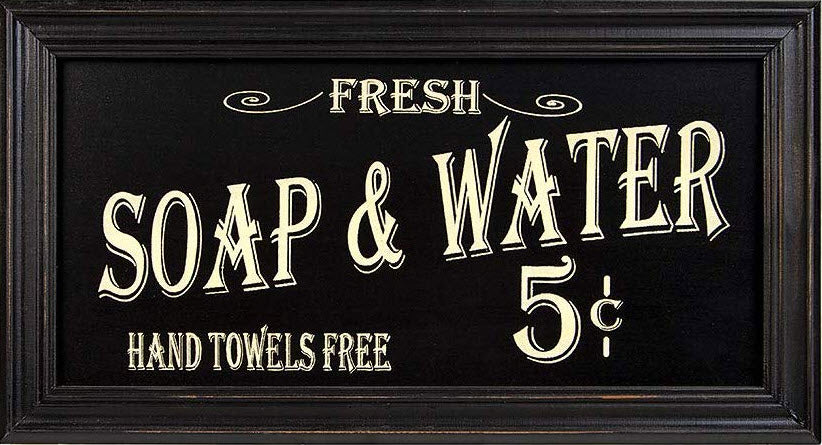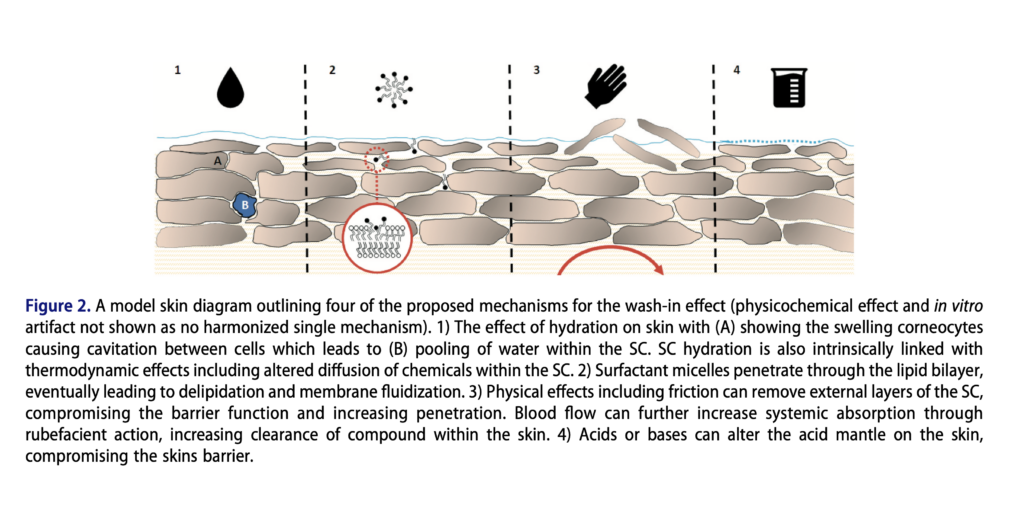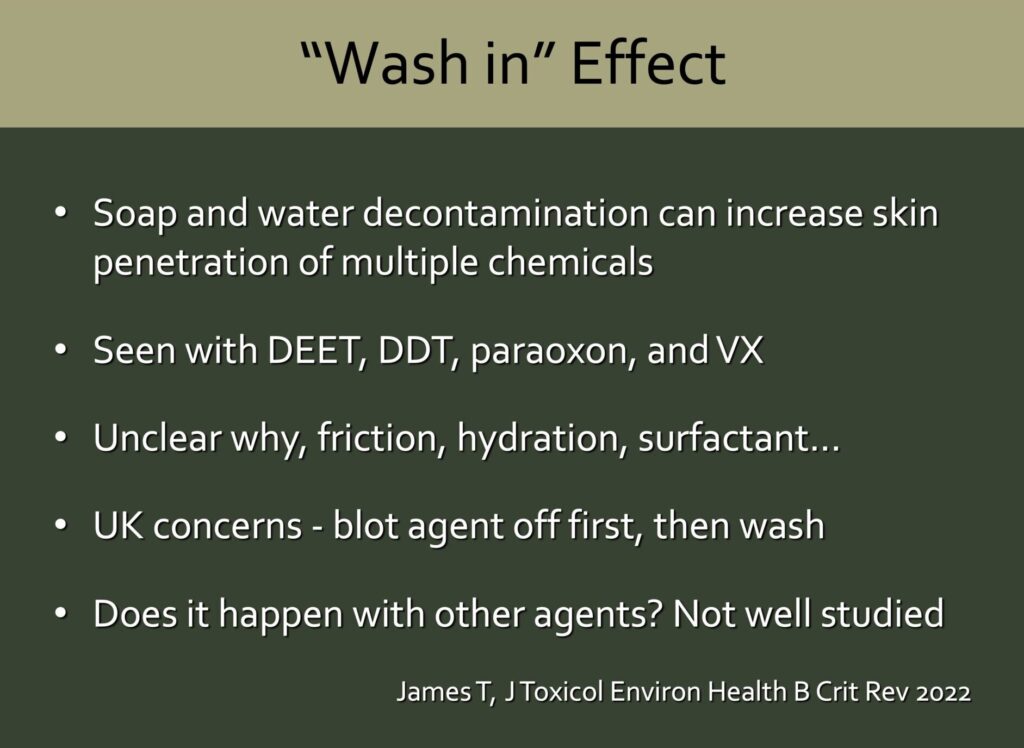
Chemical Weapons “wash in” effect
- Posted by Mike Shertz MD/18D
- Categories Tactical CBRN
🕖 Reading Time, 7 minutes
Individuals or casualties exposed to chemical warfare agents are best decontaminated by a procedure that absorbs, removes, and neutralizes the agent. Reactive Skin Decontamination Lotion (RSDL) impregnated sponges are well studied and used by US DOD for this purpose.
In a mass casualty / mass exposure incident, dedicated decontamination material is unlikely to be readily available. Soap and water are often cited as the most convenient anticipated alternative option in this setting.
However, there are multiple chemical compounds for which attempted decontamination with soap and water is not only ineffective, it actually increases the skin absorption of the chemical.
This counter-intuitive negative outcome was shown first with malathion, an insecticide, in 1974.1 It was later shown with DEET, a common insect repellant, in 1993. Increased absorption has since also been shown with DDT and paraoxon, both insecticides. Similarly, decontamination with soap and water has been shown not to decrease, but actually to increase the dermal absorption of VX nerve agent across multiple studies. This has been termed the “wash-in” effect.
One recent study showed a more than doubling of VX absorption after soap and water washing of human skin samples compared to no decontamination alone.4

There are multiple proposed mechanisms for how this might occur: They range from hydration of the skin with disruption of the outer protective layer, to surfactant effects from soap, to simple mechanical friction. Some have said that it isn’t per se that the decontamination was ineffective, but something about soap and water speeds up the onset of cholinergic effects, possibly again by skin hydration.
Although data is limited, there is literature showing decontamination by washing with just plain water (no soap) might not cause this increased penetration or “wash in” effect.2,3,4 Additionally, Forsberg showed no benefit to adding soap to water during decontamination, as both provided about the same degree of decontamination, but still less than RSDL or Fuller’s Earth.4
Therefore, if you don’t have an “official” decontamination agent available and there is a chance soap and water will increase agent absorption, do you just use plain water? The research supporting that approach is very weak, but it might be a valid plan. However, there is another study showing VX applied to wet skin increases its rapidity of penetration compared to the same dose of VX on dry skin.5 So is just water really safer?

Regardless of how this wash in effect / increased penetration effect occurs, or whether it is the surfactant effect of soap, it is bad for the exposed individual.
This concern for the “wash in” effect has led the UK to recommend dry decontamination always be done first (assuming no caustic agent exposure as they have had issues with acids being used as weapons in recent years). This dry decontamination by “blotting” the exposed skin is performed before any water exposure.
The UK also decreased the recommended decontamination shower duration from 3 minutes to 90 seconds in response to this problem. This both speeds up throughput of exposed individuals and attempts to decrease their water exposure. There is a study showing with this kind of a model there doesn’t seem to be any increased penetration of VX.
There is also evidence that this shorter shower doesn’t negatively affect the success of decontamination for agents that are specifically removed by soap and water. Thors showed that washing off RSDL that had been used to remove VX off human skin didn’t cause any increased skin penetration of the agent.3
Has this “wash in” effect been shown with other chemical warfare agents besides VX and a soman simulant? On that there just doesn’t seem to be much literature. One study showed it with a sulfur mustard simulant.2 There has been a concern that oily agents like sulfur mustard might be spread to uncontaminated body areas by washing with resultant increased toxicity.2 Unfortunately, immediately after an exposure, you might have no idea exactly what you were exposed to, or whether soap and water will make it better or worse.
What does all this mean if you or the casualty you’re caring for are contaminated by a chemical warfare agent and you have no more effective decontamination options (like RSDL, Fuller’s earth, 0.5% bleach, etc) besides soap and water? The key seems to be to physically remove as much agent as possible with some other means like dry blotting before using soap and water or water alone.
References
Unless otherwise footnoted, most of the information presented here is from this excellent review article on the “wash in” effect. It is very heavy on the science. James T, Izon-Cooper L, Collins S, Cole H, Marczylo T. The wash-in effect and its significance for mass casualty decontamination. J Toxicol Environ Health B Crit Rev. 2022 Apr 3;25(3):113-134.
This similarly timed review article on decontamination with water / soap / water comes to somewhat different conclusions: 1Chiang C, Kashetsky N, Feschuk A, Burli A, Law RM, Maibach HI. Efficacy of water-only or soap and water skin decontamination of chemical warfare agents or simulants using in vitro human models: A systematic review. J Appl Toxicol. 2022 Jun;42(6):930-941.
2Forsberg E, Öberg L, Artursson E, Wigenstam E, Bucht A, Thors L. Decontamination efficacy of soapy water and water washing following exposure of toxic chemicals on human skin. Cutan Ocul Toxicol. 2020 Jun;39(2
3Thors L, Koch M, Wigenstam E, Koch B, Hägglund L, Bucht A. Comparison of skin decontamination efficacy of commercial decontamination products following exposure to VX on human skin. Chem Biol Interact. 2017 Aug 1;273:82-89.
4Thors L, Wigenstam E, Qvarnström J, Hägglund L, Bucht A. Improved skin decontamination efficacy for the nerve agent VX. Chem Biol Interact. 2020 Jul 1;325:109135.
5Dalton C, Graham S, Jenner J. Effect of aqueous dilution on the absorption of the nerve agent VX through skin in vitro. Toxicol In Vitro. 2018 Dec;53:121-125.
6Loke WK, U SH, Lau SK, Lim JS, Tay GS, Koh CH. Wet decontamination-induced stratum corneum hydration–effects on the skin barrier function to diethylmalonate. J Appl Toxicol. 1999 Jul-Aug;19(4):285-9
Dr. Mike Shertz is the Owner and Lead Instructor at Crisis Medicine. Dr. Shertz spent over 30 years gaining the experience and insight to create and provide his comprehensive, science-informed, training to better prepare everyday citizens, law enforcement, EMS, and the military to manage casualties and wounded in high-risk environments. Using a combination of current and historical events, Dr. Shertz’s lectures include relevant, illustrative photos, as well as hands-on demonstrations to demystify the how, why, when to use each emergency medical procedure you need to become a Force Multiplier for Good.



